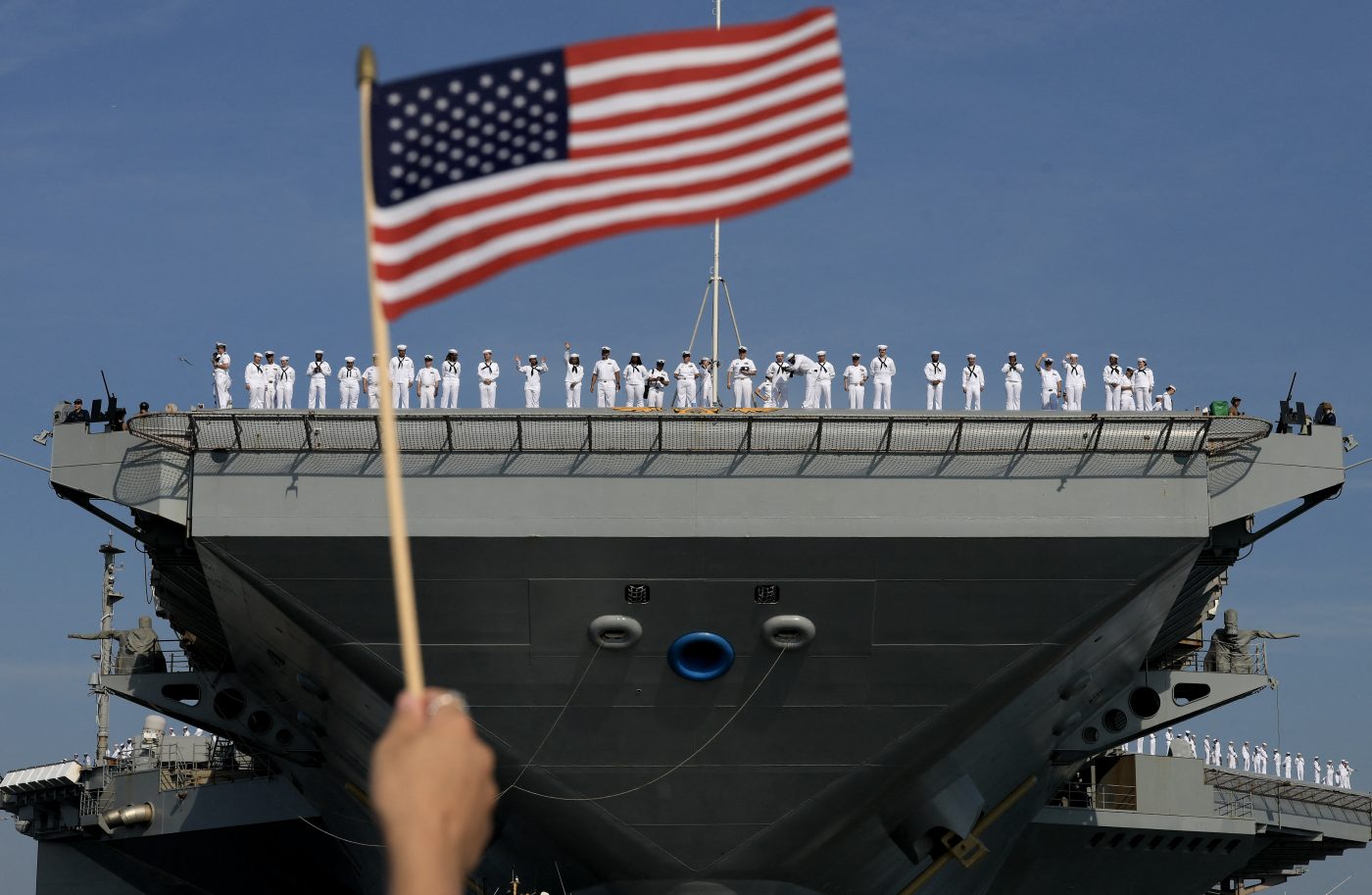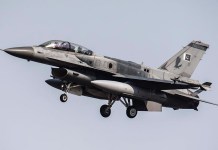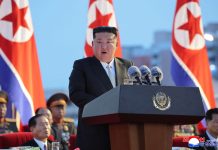The US military build-up in the South Caribbean is about to see its biggest expansion, with the USS Gerald R. Ford called from the Mediterranean Sea. The deployment has triggered fears that the war on drug cartels can quickly turn into a war against Venezuela.
Since August 2025, the US has launched a large-scale military buildup in the region, which is part of what Donald Trump calls an “armed conflict against drug cartels.”
“The enhanced U.S. force presence in the USSOUTHCOM AOR will bolster U.S. capacity to detect, monitor, and disrupt illicit actors and activities that compromise the safety and prosperity of the United States homeland and our security in the Western Hemisphere. These forces will enhance and augment existing capabilities to disrupt narcotics trafficking and degrade and dismantle TCOs,” said Pentagon’s top spokesperson, Sean Parnell.
The deployment of USS Gerald R. Ford with a ginormous air wing has been interpreted as something much bigger than just eliminating drug boats operating in the volatile South Caribbean waters.
In fact, the Venezuelan President Nicolas Maduro responded to the deployment, saying that it is an attempt at fabricating a war. Notably, while Trump has accused the Venezuelan President of being the “largest drug trafficker” in the world, a report from the United Nations Office on Drugs and Crime (UNODC) stated that Venezuela is not a cocaine-producing country and plays a minor role in the drug smuggling taking place in the region.
🚨 U.S. "enhances force presence" in SOUTHCOM and redirects the Gerald R. Ford Carrier Strike Group – the "most capable, adaptable, and lethal naval mission package in the world" – from Europe to the U.S. Southern Command AOR.
Aircraft carrier USS Gerald R. Ford (CVN 78),… pic.twitter.com/JUvF0ULWUO
— Ian Ellis (@ianellisjones) October 24, 2025
Maduro has repeatedly accused the US President, Donald Trump, of attempting to topple his government under the guise of a war against drugs.
While not speaking of a war directly, US President Donald Trump has indicated that land strikes on targets inside Venezuela are on the cards. He said that the military could launch strikes against drug traffickers abroad without Congress approving a declaration of war.
Additionally, some sources in the US administration recently told CNN that Trump is considering plans to target cocaine facilities and drug trafficking routes inside Venezuela. “There are plans on the table that the president is considering” regarding operations on targets inside Venezuela, an official said, adding that “he hasn’t ruled out diplomacy.”
This makes the deployment of the US Navy’s largest aircraft carrier extremely significant.
Gerald R Ford Carrier Strike Group (CSG) Near Venezuela
The deployment of aircraft carriers to the South American theatre is very significant because, of the 11 carriers operated by the US Navy, only three are at sea at a time — making them a highly coveted asset that must be deployed with great discretion.
This is the second time this year that the Pentagon has ordered an aircraft carrier to deploy to a major flashpoint. Before this, the US had redeployed two of its carriers to the Middle East region amid hostilities between Israel and Iran, and a campaign against the Yemen-based and Iran-backed Houthis militia.
In a latest report, the US-based think tank, CSIS (Centre for Strategic and International Studies), insinuated that the deployment of USS Gerald R. Ford was likely aimed at conducting strikes on Venezuela rather than anti-drug ops. “The administration attributes the aircraft carrier’s deployment to the counterdrug mission, and several of its wide range of capabilities can help with ongoing operations. Overall, however, carriers are poorly suited for the surveillance tasks entailed with stopping drug smugglers. On the other hand, they are superbly suited for conducting air attacks and supporting amphibious landings.”
The USS Gerald R. Ford (CVN-78) is the world’s biggest aircraft carrier (displacing 100,000 tons) and the newest in the US Navy. The carrier stretches 1,092 feet, and can embark a total of 90 aircraft, including F-35C Joint Strike Fighters for stealthy penetration, F/A-18E/F Super Hornets for multirole strikes, the EA-18G Growler for Electronic Warfare (EW), and the E-2D Hawkeye for air surveillance. It also includes C-2A Greyhound and MH-60R/S Seahawks helicopters that could fire anti-ship missiles at drug-laden vessels.

While the announcement did not specify which warships would accompany the super carrier on this deployment, reports suggest that the USS Winston Churchill, USS Bainbridge, and USS Mahan would serve as escorts. Two other warships that set out for sea during Ford’s deployment to the Mediterranean, USS Forrest Sherman and USS Mitscher, were operating independently of the carrier in different locations.
These three vessels will bring the total number of Vertical Launching System (VLS) cells in the region to over 700 for US naval troops. These ships carry a range of missiles, including SM-6s for air defense and Tomahawks for long-range strikes.
The Tomahawk Land Attack Missile (TLAM) is a staple of the US’s precision-strike capabilities. In June 2025, the US Navy launched 30 Tomahawks at Iran’s nuclear facilities from an Ohio-class guided-missile nuclear submarine.
In fact, Ukraine has been pleading with the Trump administration to arm it with the deadly Tomahawk missiles to conduct long-range strikes on Russian targets deep inside the country.
Since Donald Trump has yet to authorize such a transfer, the Tomahawks could possibly hit Venezuela before they hit Russia.
“With an average loadout across the force of 25 percent land attack missiles, roughly 180 Tomahawks would be available for strikes against the Maduro regime or cartel facilities,” said the CSIS report.
If push comes to shove, the cutting-edge, combat-proven fighter jets stationed aboard the USS Gerald R. Ford could swiftly launch from the carrier to conduct airstrikes on Venezuelan military bases, command centers, oil infrastructure, ports, or alleged drug facilities.
The carrier and the destroyers accompanying it could be positioned about 300 kilometers from Venezuela, whereas the fighter jets deployed in Puerto Rico would have to fly 800 kilometers to carry out strikes.
The Advanced Weapons Elevators (AWEs) Ford enables roughly up to 150 sorties per day. It would allow sustained bombing campaigns to degrade Venezuela’s air defenses early, creating a no-fly zone. The combination of warships firing long-range missiles and F-35C and Super Hornet conducting land strikes could cripple Venezuela in a conflict scenario.
In fact, the carrier air wing could neutralize much of Venezuela’s Air Force, which mainly includes the Su-30 and archaic F-16 fighter jets.
This feat may not be easy, given that Venezuela has deployed 5,000 air defense systems, as Maduro recently announced. However, US forces could conduct SEAD (Suppression of Enemy Air Defense) system and obliterate much of the country’s air force within days.
The E-2D Hawkeye early-warning aircraft aboard the carrier can provide radar coverage of more than 200 miles (about 321 kilometres) to detect and neutralise imminent threats.
The carrier could also potentially provide close air support for amphibious assaults or special forces insertions to target individuals inside Venezuela’s territory.
In a hypothetical conflict, the USS Ford could threaten Venezuela through its unmatched power-projection capabilities, leveraging its air wing, defensive systems, and integration with joint forces. Meanwhile, Venezuela’s military, reliant on aging Soviet or Russian equipment, would face significant challenges against such a platform.
Though Donald Trump has not explicitly mentioned the potential of a war with Venezuela, he has dodged questions over the CIA’s authority to assassinate Nicolas Maduro. Any such attempt on the Venezuelan leader’s life or land operations against the South Caribbean country could spiral into a bigger conflict.
Whether that is Trump’s endgame remains to be seen, but the newly renamed ‘Department of War’ seems to be up to something big.
- Contact the author at sakshi.tiwari13 (at) outlook.com
- Follow EurAsian Times on Google News




